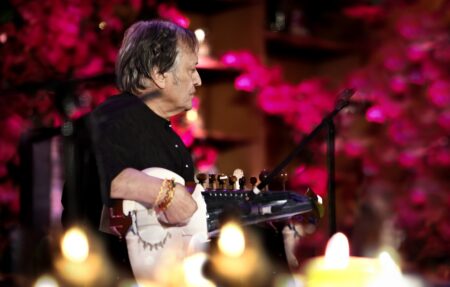Rama Navami music festival by Mani Krishnaswami Academy featured seven distinctive compositions of Chitravina Ravikiran
Rama Navami is the day on which Rama, the seventh incarnation of Lord Vishnu, embodied in human form in the kingdom of Ayodhya. To celebrate this auspicious day, (April 21), Mani Krishnaswami Academy, Mangalore, presented seven bhajana marga kritis composed by well-known musician Chitravina N. Ravikiran, rendered by over 100 artists in seven ensembles.
Six of the seven kritis presented here were led by one of Ravikiran’s performing disciples, each distinguished in their own right in the field of Carnatic Music. The final one was performed by them harmoniously. Each of the performing artists was accompanied by some of their students to make the event a grand show with nearly 100 participants that also included guest participants such as Aditi Prahalad, Swarathmika Srikanth, and V K Arun Kumar.
Though the participants performed individually in their own homes, the virtual program came together beautifully with excellent video and audio editing. Some of the songs in this program were composed by Ravikiran when he was around 12-14 years old while a few others were more recent creations.
The music was interspersed with insightful discussions between Muralidhar Shenoy and Ravikiran on the history of devotional music in South India, the art of composing, and advice for students and cultural enthusiasts.

Melodious ragas
To begin this series, a short but elegant piece, “Rama chandra, rama chandra rama rama ram”, led by Sowmya Acharya, Founder of Acharyanet was presented in the raga Hamir Kalyani. The elegant glides from Pa to Sa heightened the raga’s beauty which was further enhanced by delicate and intricate phrases. The choice of composing this song in tishra gati added a bright and spirited dimension to the composition.
The next kriti, “Niratishaya phala”, was in the raga Kurinji and set to Adi Talam. This kriti was slower and melodious, which was able to complement the mellow tones of the raga. The composition that described the many qualities of Lord Rama had antyaprasam along with a small jathi that was incorporated into the sahityam. This song was led by vocalist Apoorva Ravindran.
To contrast the rasas brought out in Kurinji, the next piece was in Sindhubhairavi which utilizes all the 12 tones in an octave, which can project different moods in a song. This Kriti felt encompassing and ambient. This song was led by Apoorva’s illustrious sibling, Anahita Ravindran.
The next piece in Jhunjhooti (Shenjurutti) was in a highly Sanskritised Kannada replete with alliterations such as, “Trimurti roopa triloka papa tritapa kopadri nasha shreepa”. This song was led by the reputed musician and mentor Bhargavi Balasubramanian, who also accompanied the song on the Chitravina.
Perfectly choreographed
‘Shree ramam bhajare’ in the raga Kapi with a lot of evocative appeal was led by the prodigious vocalist and Chitravina artist, Vishaal Sapuram. The next kriti in the rich and regal raga PunnagavarAli, ‘Narayana vara naradadi gana’, made a reference to Ramaavatara in the final stanza. It was led by the dynamic vocalist Vanitha Suresh, from the USA. The concluding song was an effervescent song, ‘Rama rama’ in Poorvikalyani, set to tishra gati adi talam.
Though all kritis in the program were composed in Adi talam, the difference in tempos and pulses added variation. While some songs were more meditative, others had a more lively feel.
The event was greatly appreciated by music lovers all over the world for its melodic content, selection of ragas and languages, beautiful interpretation of the lyrics, and the overall orchestration of the program.




